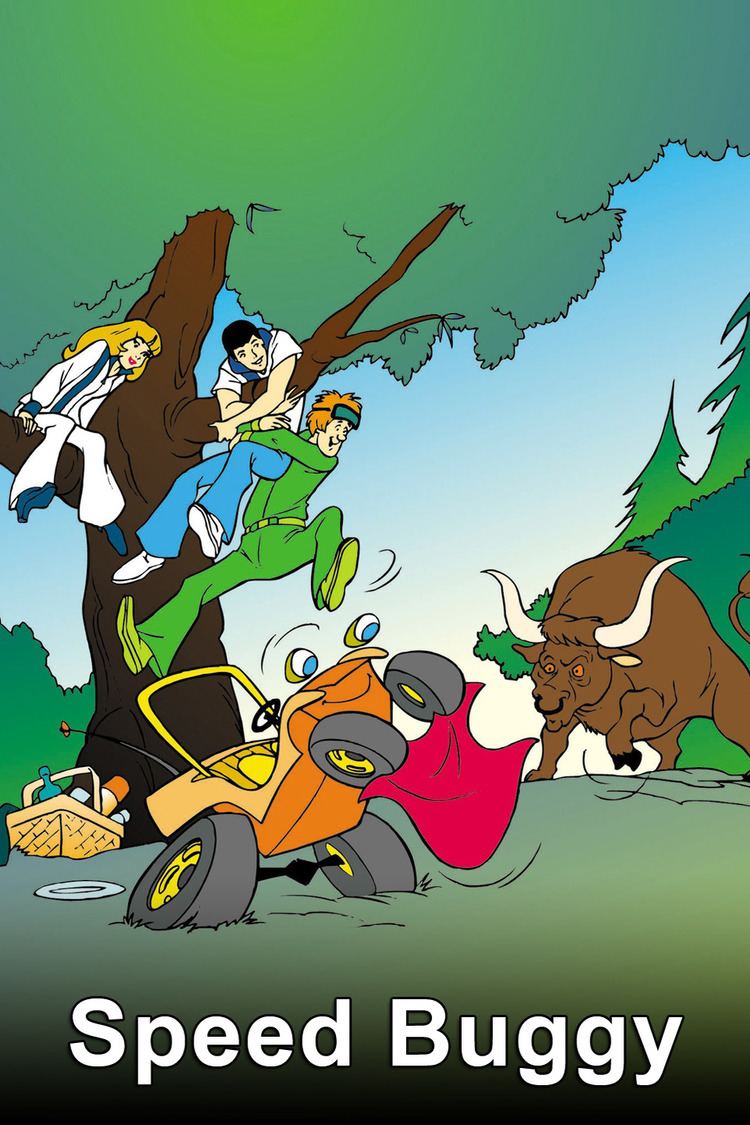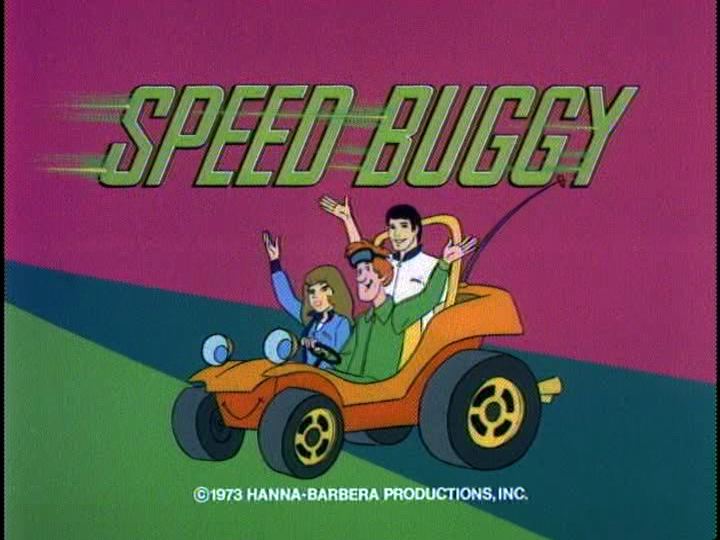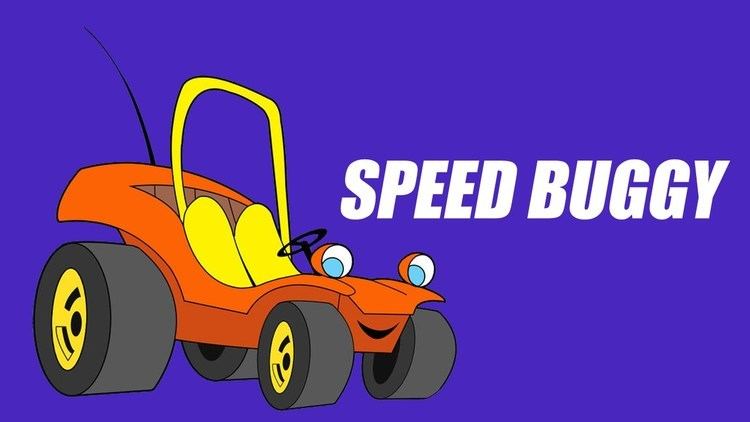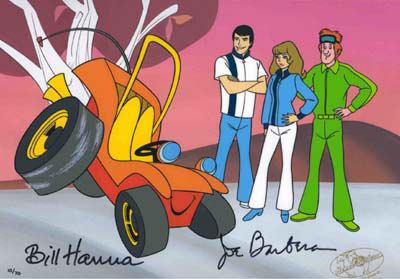7 /10 1 Votes
7.3/10 TV First episode date 8 September 1973 | 6.9/10 IMDb Genre Animation Country of origin United States Final episode date 22 December 1973 | |||||||||||||||||||||||||||||||||
 | ||||||||||||||||||||||||||||||||||
Voices of Mel BlancMichael BellArlene GolonkaPhil Luther Jr. Cast | ||||||||||||||||||||||||||||||||||
Speed Buggy is an American animated television series, produced by Hanna-Barbera, which originally aired for one season on CBS from September 8, 1973 to December 22, 1973. With the voices of Mel Blanc, Michael Bell, Arlene Golonka and Phil Luther Jr., the show follows an orange dune buggy who, alongside teenagers Debbie, Mark, and Tinker, solves mysteries while participating in racing competitions around the world. The series was produced by Iwao Takamoto, executively produced by William Hanna and Joseph Barbera and directed by Charles A. Nichols.
Contents

The series was originally developed under the working titles Speed Bug and Speed Buggs before it was settled as Speed Buggy. Takamoto was less involved with the series due to the trust he had for storyboard and animation artists Bob Singer. The concept for the show was inspired by the 1968 Walt Disney Pictures film The Love Bug and the Speed Racer anime franchise. Several of the storylines and plots originated on Hanna-Barbera's other animated series Josie & the Pussycats.

Speed Buggy lasted for one season with a total of sixteen episodes. Despite its short run, it was broadcast on the Big Three television networks years after its original run as the channels had purchased syndication rights. It was speculated that the series acquired a fan base due to its frequent rotation on American television. Critical response to Speed Buggy was generally positive; some critics enjoyed its shared themes with Josie & the Pussycats and Scooby-Doo, Where Are You!, while others found it unmemorable and overly repetitive. It has since been released on DVD as part of Warner Bros.' Archive Collection on a four disc set.

Premise
Set in an assortment of locations around the world, the series follows three teenagers (Mark, Debbie, and Tinker) and a talking dune buggy as they partake in various adventures. Speed Buggy, the dune buggy, was designed by Tinker and participates in racing competitions in order to collect "winner's trophies". During their travels, the crew often defeats villains and crooks in order to save the world, such as diamond thieves, car-obsessed doctors, and evil pirates. Known as the "Speed Buggs", the group of three teenagers is able to activate Speed Buggy through the use of a portable walkie-talkie. Several episodes in the series feature reworked versions of storylines from Hanna-Barbera's own Josie & the Pussycats.
Characters
The series features the following four main characters throughout its run:
Production and creation
Speed Buggy was developed with the working titles Speed Bug and Speed Buggs. The show's concept was partly inspired by the 1968 Walt Disney Pictures film The Love Bug and the Japanese Speed Racer franchise. It was hinted by author David Hofstede that the "Chugga-Boom" vehicle in Hanna-Barbera's The Perils of Penelope Pitstop served as a prototype for the vehicle in Speed Buggy. Executively produced by William Hanna and Joseph Barbera's Hanna-Barbera Productions, Charles A. Nichols served as the director and Art Scott was the associate producer. Iwao Takamoto, the main producer, expressed in his posthumous 2009 autobiography that the creation of Speed Buggy occurred due to the success of his other productions Josie & the Pussycats and Scooby-Doo, Where Are You!. He wrote that his participation in the series was partly because he enjoyed getting "[his] hands on a show whenever [he] felt it was necessary", but was overall less involved than necessary due to his trust with Bob Singer, an animation artist for Hanna-Barbera productions.
Jack Mendelshon and Chuck Menville were the two head writers for the episodes. Several other writers contributed to the series, including Lars Bourne, Len Janson, Joel Kane, Jack Kaplan, Woody Kling, Norman Maurer, and Larry Rhine. The main title theme for Speed Buggy was copyrighted in November 1975; it was composed by Hoyt Curtin under the supervision of Paul DeKorte. Besides the leading roles, other voice actors involved with the series include Janet Waldo, Hal Smith, John Stephenson, and Mike Road.
Broadcast history
Speed Buggy was broadcast on CBS as part of their Saturday morning children's lineup between September 8 and December 22, 1973. Before being cancelled, it continued to air regularly until August 31, 1974. After its original run, CBS included reruns of Speed Buggy in their children-oriented television blocks, it was broadcast from February 4, 1978 to September 2, 1978 and September 18, 1982 to January 29, 1983. It also played on both ABC and NBC, when they acquired syndication rights for the series. ABC aired it at noon in 1975-1976 and NBC aired it in 1978. According to The A.V. Club's Will Harris, the series was successful and had a large fan base because it aired on all three major television networks in the 1970s.
Boomerang has broadcast Speed Buggy on several occasions since its initial launch in 1992. As part of a Valentine's Day event in February 2007, the channel aired the program alongside other cartoons such as Tom and Jerry, The Jetsons, and Dexter's Laboratory. The episode "Speed Buggy Went That-a-Way" was featured on the Warner Bros. Presents DVD compilation Saturday Morning Cartoons – 1970's Volume 1 and released on May 26, 2009. As part of the Warner Bros. Television Distribution's Archive Collection, the complete Speed Buggy series was made available on DVD as a four-disc set.
Critical response
Aubrey Sitterson of Geek.com included Speed Buggy on their unranked list of "favorite Scooby-Doo knockoffs". He noted similarities between Speedy and Scooby-Doo's "Mystery Machine", and joked that Tinker is "basically just Shaggy in a jumpsuit". However, he hinted that Speed Buggy's success could have been derived from its shared storylines as seen on Josie & the Pussycats. Similarly, Harris from The A.V. Club agreed and wrote that the main difference between the two shows was that Speed Buggy "substitut[ed] racing for rock 'n' roll". He also claimed that the main character "confirm[ed] that sidekicks don't always have to be animals". Speed Buggy and the Scooby-Doo gang would be featured in a crossover episode ("The Weird Winds of Winona") in the second installment of the Scooby-Doo franchise, The New Scooby-Doo Movies (1972-1973).
David Mansour, author of From Abba to Zoom: A Pop Culture Encyclopedia of the Late 20th Century, wrote in his book that Speed Buggy shared several characteristics with Hanna-Barbera's Scooby-Doo, Where Are You!. He speculated that Mark was the "Freddy-esque handsome brain", Debbie was the "Daphne-esque pretty girlfriend", and Tinker was the "Shaggy-esque mechanic and driver". Furthermore, he considered Speed Buggy to be one the most "famous dune buggies of pop culture" alongside the buggies in The Funky Phantom, The Banana Splits, and the Big Jim toy line. In a retrospective view of older cartoons, the staff at MeTV included the show on their list of "15 Forgotten Cartoons from the Early 1970s You Used to Love". On a more negative note, author David Perlmutter found Hanna-Barbera's use of "humanized automobiles" to be too predictable and repetitive.
Legacy
Speed Buggy would not be the last time Hanna-Barbera incorporated automobiles into animation. Both Wheelie and the Chopper Bunch and Wonder Wheels also featured cars that were able to talk and act like humans. Perlmutter grouped the three shows together, calling them a "trilogy". Wonderbug, an occasional live-action segment on ABC's The Krofft Supershow (1976-1978), featured three teenagers and a talking dune buggy and often drew comparisons to Speed Buggy. Also compared to the show was Adult Swim's Mike Tyson Mysteries, with Rolling Stone's James Montgomery calling it an ode to classic cartoons like Speed Buggy, Scooby-Doo, and Captain Caveman and the Teen Angels.
The characters in Speed Buggy would also be featured in a 1973 Milton Bradley board game, where players would race Speed Buggy and other buggies in a fictionalized version of Baja California. Speedy would also make cameo appearances in later cartoons, including Johnny Bravo, My Life as a Teenage Robot, Invader Zim, Animaniacs, South Park, and Harvey Birdman, Attorney at Law.
